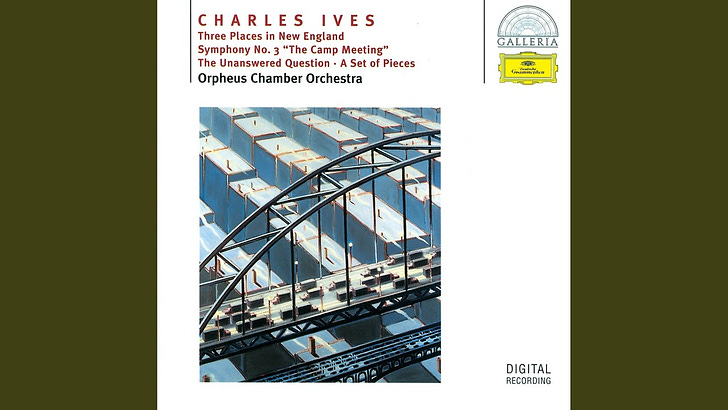The Charles Ives Society “Charles Ives and Jazz” panel with Jack Cooper, Bill Frisell, Eric Hofbauer, Phil Lesh, and David Sanford, moderated by Judith Tick, was a blast. When it’s up, I’ll share a link.
This Ives post is part four of four. Previously:
Charles Ives and Jazz?
I’m participating on a panel about Charles Ives this week, which is giving me a chance to organize my thoughts about this crucial American composer.
TT 302: Footnote: My Personal History with Charles Ives
My first girlfriend (and eventually, first wife) was the fine mezzo Karen Goldfeder. We would read through a fair amount of easier lieder and song rep together: the Schirmer editions of Italian arias, the Unknown Kurt Weill, and so forth. In an anthology of Western music we discovered “General William Booth Enters Into Heaven.” At first glance, it seem…
TT 303: Charles Ives and the Blues?
Ragtime? Yes. Slightly syncopated melodies over a hint of marching “oom-pah” bass are everywhere in Charles Ives. A personal favorite is “In the Inn,” heard in the Piano Sonata No. 1, also arranged for ensemble as part of A Set of Pieces. The recording by Orpheus Chamber Orchestra (featuring Gilbert Kalish as guest pianist) is just great.
While getting ready for the panel, I refreshed the Ives repertoire. Essential listening for beginners includes Three Places in New England, The Unanswered Question, and the 3rd Symphony. (In earlier posts I reference a few other personal favorites, including “General William Booth Enters Into Heaven,” “From Hanover Square North, at the End of a Tragic Day, the Voices of the People Again Arose,” and the ensemble arrangement of “In the Inn.”)
The recent set of Dudamel conducting the LA Phil in the four Ives symphonies is very good overall, but I was brought up short by something I’d never heard before, the Symphony No. 1.
I was reminded of a similar experience when dutifully rounding out the process of listening to all of Stravinsky. Stravinsky’s early Symphony in E-flat rarely turns up in the general history books but it, too, turned out to be something of a shock.
Ives wrote his maiden voyage between 1898 and 1902; a few movements were his senior thesis overseen by his teacher Horatio Parker.
Stravinsky’s example is from just a couple of years later, 1905–1907, and written under and dedicated to his mentor Rimsky-Korsakov.
I have no doubt that specialists can point out how these student works have Ivesian or Stravinskian details. But in a blindfold test, a listener at my level would have no idea that these fine extended romantic works were created by two of the outstanding revolutionaries of 20th-century sound.
Both works hew closely to 19th-century models, are in four movements, and last about 40 minutes. Coincidentally, both saw the same year for first commercial release on record, 1966. (Morton Gould did the Ives, Stravinsky himself conducted for his complete Columbia overview).
The similarities end there. Ives is following the Brahms/Dvořák line, and Stravinsky is influenced by Tchaikovsky and Glazunov. And while the surface of both pieces are reasonably unruffled, under the hood it turns out that Ives takes far more risks melodically and harmonically than Stravinsky. (In a comment on FB, noted Ives expert Kyle Gann suggests that, “Ives's approach to modulation is actually something like Busoni's in his Piano Concerto: frequent modulations via pivot note, but never any ambiguity about what the new key is (in contrast to Schoenberg, Mahler, Strauss, Reger, et al).”)
In terms of practical use: Ives never heard his first symphony played live or received feedback from any conductors or players. Stravinsky heard it his piece with his teachers and mentors Glazunov and Rimsky-Korsakov also present in the hall. This experienced committee told the student composer to his face that he needed to fix certain things; Stravinsky followed their advice, re-edited the work, and published an Op. 1.
It would continue like that. Ives worked almost in secret, like a mad scientist, while Stravinsky went into the world, writing on commission for ballet and other stage productions, where constant adjustment and refinement was inevitable.
As a result, Ives is the quintessential “problematic” composer — problematic in the old sense of “open to question or debate.” Many major Ives compositions have an editorial history that is like a miniature Talmud, with years of queries and responses.
In sharp contrast, almost all of Stravinsky is easily playable and much of it is in the repertoire. You open the score and read the notes, and that’s that.
It was not just temperament, of course. In terms of the musical nitty-gritty of their most famous works, Ives and Stravinsky have little to say to each other. That’s as it should be…and, for that matter, their divergent ways of working are obviously unimpeachable. We wouldn’t want either of these geniuses to have done anything different. Both legacies are magnificent and sui generis.
Still, for me it was something of a revelation to contemplate the strange unity of Ives’s Symphony No. 1 and Stravinsky’s Symphony in E-flat. While perhaps neither deserves to be in steady rotation on the concert stage, both symphonies are well made. An old saw holds, “First know the rules before you break them.” Ives and Stravinsky prove this old saw to be true, at least in these two memorable cases.




I remember my dad giving me a little bit of a hard time when I was a kid for picking the first symphony and Variations on America as the Ives I'd listen to on my own, rather than his more interesting later stuff. I was a kid man, I didn't like mustard or onions, either!